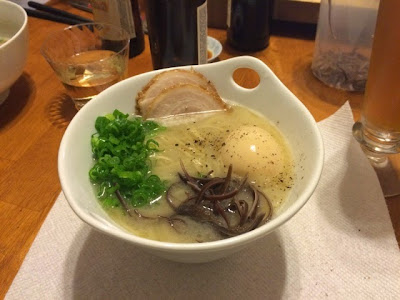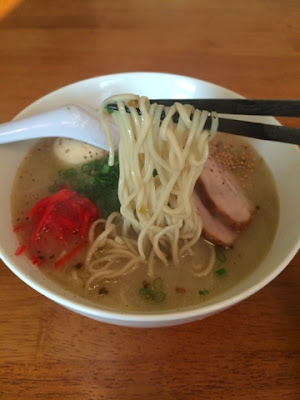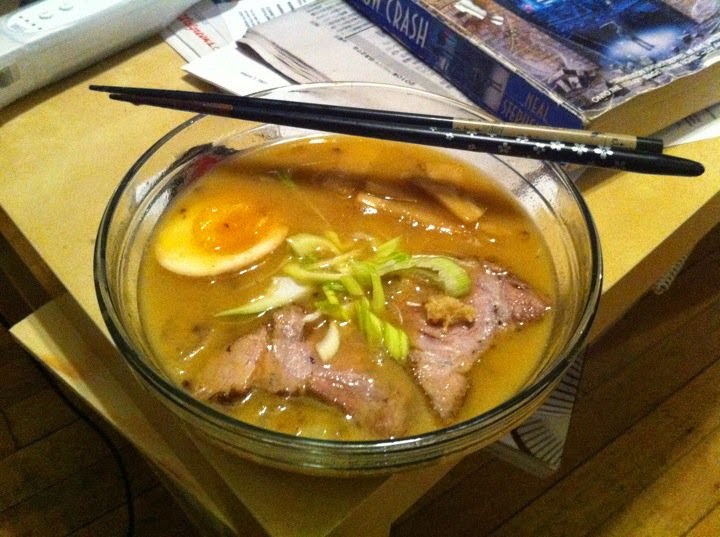While currently, I've made some, frankly, awesome bowls of noodles, it wasn't always that way.
No no, the first few ramen bowls I made were insanely terrible. Awful.
Like a slap in the face to what "ramen" is.
So, being the smart man I am, I figure it'd be cool to start the blog off by discussing those dishes in detail. I'll essentially gloss over:
- Why they sucked.
- What I did wrong.
- What I learned from those experiences.
Ugh... here we go.
The first bowl I ever made was a "Tonkotsu" broth with homemade noodles.
At the time of its inception, I didn't even understand why Tonkotsu worked, or what it necessarily meant, or what ingredients were required to make the dish. I just knew it was white, had pig bones, and was delicious.
At first, I thought I was on the right track. I had done some initial research and discovered that tonkotsu required a high heat boil to get creamy white. I threw some pig trotters into water with chicken, carrots, onions, and let them cook at rapid boil.
So when this showed up after 8 hours of simmering, I thought I was golden:
I mean, it was opaque, and whiteish. That worked for me! It was a little orange, but I hardly knew better.
I also made noodles... they looked cool but... oh dear the shame.
Without the right protein and gluten content, and with far too much water in the dough, these noodles were soggy, and horrible tasting.
But hey! In my euphoria of first attempts, who cared?! This was ramen made at home. That was pretty sweet.
In my haste and utter lack of knowledge, I threw on a bit of seared chicken, some far-too-thickly cut green onions, and canned bamboo shoots. No seasoning beyond salt in the broth. Here it is... my first homemade bowl of ramen:
Later on in the week, I made another bowl using the same tonkotsu base, but topped it with pork, onions, and an egregiously overcooked egg.
Now, some of you might think that these bowls of noodles look pretty good! And, honestly, they're not too bad! But they paled in comparison to what I had experienced in Japan. The bowl above was ultra heavy, insanely rich, not nearly complex enough, with very little depth. I knew if I were to satisfy any sort of craving, I'd have to do better.
As I continued my research, things started to improve. I began looking back to what I had learned in my experiences in Sapporo, like how they used aromatic lard infused with ginger and garlic, and how they used miso and sesame to add richness and complexity. I also decided to start focusing my efforts on Miso ramen, my favorite style.
But... even then, it was kinda sad:
I didn't even use matching chopsticks.... gahhhh.
Noodles continued to haunt me too, as I was unaware of the affects of things like alkalinity, flour ash, water content, dough fermentation, and cooking times. They just never turned out right. They were like pasta...
I gave up on making noodles for a while, opting to buy noodles from Sun Noodle instead. They make a killer product, but there's something alluring about making everything at home. But things were starting to look up!
The truth is, it took several years before I felt like I had any clue what I was doing. Ramen is far more complex than it leads on to be. I like to imagine that these days, my bowls have improved dramatically from my humble origins, but there is always room for improvement. Here are a few recent creations, for comparison's sake:
Old School Tokyo Shoyu, with chashu pork, spinach, egg, nori, and menma
Chicken/Dashi Shio Ramen, with menma, egg, nori, green onion, and chicken chashu
Sapporo Miso, my love.
But things continue to improve, and I continue to learn. That's what this blog is for! To share my growth as a lover of ramen, a lover of cooking, with you.
The quest continues.































